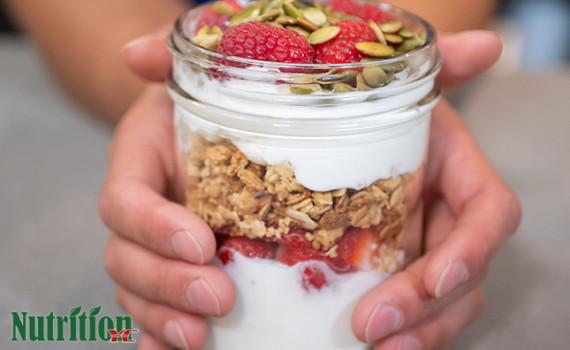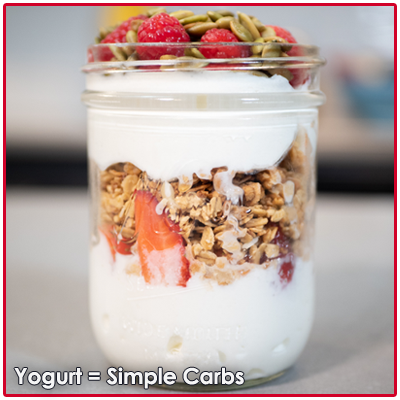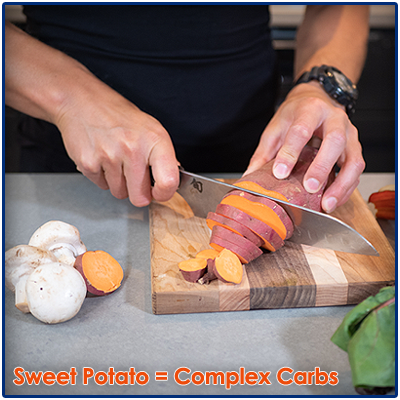
Simple vs. Complex Carbs: What’s the Difference, When to Consume Each & Pre-workout Fueling Strategies
Category:carbohydrates,fuel,nutrition,performanceCarbohydrates are an essential component of the diet, particularly for athletes, as they provide our muscles with the energy needed to function correctly (contract) and perform optimally for strength and endurance. Today, confusion over carbs exists because of conflicting information: current fad diets give carbohydrates a bad rap, and food manufacturers reign with producing and successfully marketing more and more calorie-dense, nutrient-deficient processed and refined food products. Fortunately, we are here to break it down for you, and help you understand what you need to know to make the best decisions for your health and performance.
Carbohydrates are often divided into two main groups: simple and complex. These terms are used to refer to the speed of digestion and absorption of nutrients by the body. “Simple” carbs are digested and absorbed relatively quickly compared to “complex” carbs, which take more time to be processed. You’re probably wondering what components increase or decrease the time it takes for a carbohydrate-rich food to be digested and absorbed. Good question! This depends on the fiber, starch and sugar content of the carbohydrate.
Simple carbs
 Let’s start with sugar. Table sugar, scientifically known as sucrose, is a disaccharide (“di” = two, “saccharide” = sugar), meaning it is composed of 2 sugar molecules: glucose and fructose. Glucose and fructose (and galactose) are considered monosaccharides (single sugar units), which are in their simplest form, and can’t be broken down any further by the body. Since table sugar (sucrose) only needs to be split once to be used for energy, it makes sense that foods with higher amounts of sugar take less time to process and therefore fall into the “simple” category. Simple carbs elicit an insulin response, which stimulates the uptake of sugar into our cells in order to be used for energy. These types of carbohydrates are beneficial in situations where you’re about to start some form of physical activity and need quick fuel, or in the middle of a long and/or intense activity and need something to sustain energy levels even further. Simple carbs are also great for post-activity/training in order to replenish carbohydrate stores that were lost and to promote muscle recovery. With less activity or when mostly sedentary, the body is not in need of instant energy from simple carbohydrates, so this is a good time to focus on complex carbohydrates.
Let’s start with sugar. Table sugar, scientifically known as sucrose, is a disaccharide (“di” = two, “saccharide” = sugar), meaning it is composed of 2 sugar molecules: glucose and fructose. Glucose and fructose (and galactose) are considered monosaccharides (single sugar units), which are in their simplest form, and can’t be broken down any further by the body. Since table sugar (sucrose) only needs to be split once to be used for energy, it makes sense that foods with higher amounts of sugar take less time to process and therefore fall into the “simple” category. Simple carbs elicit an insulin response, which stimulates the uptake of sugar into our cells in order to be used for energy. These types of carbohydrates are beneficial in situations where you’re about to start some form of physical activity and need quick fuel, or in the middle of a long and/or intense activity and need something to sustain energy levels even further. Simple carbs are also great for post-activity/training in order to replenish carbohydrate stores that were lost and to promote muscle recovery. With less activity or when mostly sedentary, the body is not in need of instant energy from simple carbohydrates, so this is a good time to focus on complex carbohydrates.
“These types of (simple) carbohydrates are beneficial in situations where you’re about to start some form of physical activity and need quick fuel”
Complex carbs
 Switching over to complex carbohydrates, this is where fiber and starch come into play. Fiber is the structural component of plants (think cell walls), and is a non-digestible polysaccharide (many sugar units). This means the breakdown process requires more effort (and is more “complex”) since there are numerous sugar units that need to be broken down into simple sugars. High fiber foods are more filling, because food stays in your stomach longer due to the complexity of the digestive process. When our food digests quickly as we eat (such is the case with simple carbs), we inevitably are able to eat more, which is why it’s so easy to over-consume candy, cookies, soda, juice and other treats. Starch is a polysaccharide that can be digested by the body, and is found in some of the same foods as fiber. Potatoes are a good example of starchy carbohydrates, although they do contain fiber in the skin. Due to the longer chains of sugars, starches are also considered complex. Aside from pre, during and post workout fuel/snacks, most of our carbohydrate intake should be from complex sources in order to provide us with slower-releasing, sustained energy throughout the day.
Switching over to complex carbohydrates, this is where fiber and starch come into play. Fiber is the structural component of plants (think cell walls), and is a non-digestible polysaccharide (many sugar units). This means the breakdown process requires more effort (and is more “complex”) since there are numerous sugar units that need to be broken down into simple sugars. High fiber foods are more filling, because food stays in your stomach longer due to the complexity of the digestive process. When our food digests quickly as we eat (such is the case with simple carbs), we inevitably are able to eat more, which is why it’s so easy to over-consume candy, cookies, soda, juice and other treats. Starch is a polysaccharide that can be digested by the body, and is found in some of the same foods as fiber. Potatoes are a good example of starchy carbohydrates, although they do contain fiber in the skin. Due to the longer chains of sugars, starches are also considered complex. Aside from pre, during and post workout fuel/snacks, most of our carbohydrate intake should be from complex sources in order to provide us with slower-releasing, sustained energy throughout the day.
Examples of simple carbs
Now that you know the difference between simple and complex carbohydrates and the types of scenarios in which it’s best to consume each, let’s talk about which foods belong in each category! When it comes to simple carbohydrate options, it’s important to understand that there are many whole foods that contain natural sugars, so foods with lots of added sugars (like candy and cookies) aren’t necessary to provide us with the benefits of rapid energy. For example, foods like yogurt, milk and fruit juice contain natural sugars. Other simple carb foods include breads and pastas (made with refined white flour), most breakfast cereals, honey, jams, soda, crackers, cookies, cakes, candies and other ‘treats’.
Examples of complex carbs
While highly processed, nutrient-poor complex carbohydrates do exist, this is much less common compared to simple carbs. The majority of complex carbs come to us in the form of whole grains such as barley, oats, rice, quinoa and corn, as well as whole grain products like pastas, breads, crackers etc. Other complex carbohydrates include vegetables, beans/legumes, nuts and seeds.
What about fruit?
Fruits are somewhat tricky to classify between simple and complex carbohydrate groups because they contain sugar AND fiber. However, depending on the fruit, the sugar to fiber ratio can be very high, in which case, it would act more like a simple carb. This includes fruits such as bananas, mangoes and pineapple. On the other hand, fruits that are naturally lower in sugar but high in fiber, such as berries and pears, can be considered more “complex” than “simple”. Think of this classification as a spectrum rather than linear with absolutes as many foods share components of each.
Fiber additives + supplements
In today’s world of refined and fortified foods/food products, there are now “functional fibers”, which may be extracted from natural sources or made in a lab, that are used to fortify foods that don’t normally contain fiber (for example: “fibered up”Splenda). This allows companies to claim that their products are “healthy” when really they contain very little nutrition. Extracted natural fibers include lignin, cellulose, pectin, gum, and psyllium. On that note, let’s talk about fiber supplementation for a minute, such as popular brands like Metamucil, Benefiber and Citrucel. While we aren’t necessarily anti-fiber supplementation, the amount of naturally-occurring fiber in our diet tells us a lot about the quality of carbohydrate we are consuming, and if this is low, it would best serve you to try to increase that number by opting for more unprocessed, unrefined whole foods like fruits, vegetables, beans, nuts, seeds and whole grains. Additionally, fiber additives and supplements can cause GI distress, and should not be relied upon for normal GI functioning. We recommend talking with a dietitian or doctor if this is the case for you.
Pre-workout fueling
It only makes sense to discuss pre-workout fueling strategies now that we’ve discussed the different types of carbohydrates, since carbs are the primary focus leading up to a training session or event. Depending on the timing, this can mean a larger focus on complex carbs or simple carbs. For most big meals leading up to an event or training session, there should be an emphasis on complex carbs so long as the event is not for another 3-4 hours giving your body time to properly digest. This can include options such as oatmeal, bagels, and whole wheat bread with fruit. Lighter meals/snacks consumed within 2 hours of an event or training session should contain mostly simple carbs, and anything within an hour of go-time should contain simple carbs ideally in the form of liquids or gels to serve as readily available fuel and decrease GI distress during physical activity. Pre-workout simple carb options can include cereal with milk, jam on toast, pretzels, raisins (or dried fruit) and granola bars. Sports drinks, fruit pouches, carbohydrate mixes, energy gels and chews are best in close proximity to your event/training.
Final thoughts
Hopefully you have a much better understanding of simple vs complex carbohydrates and understand the roles of each for your health and performance. Understand that these labels aren’t mutually exclusive; food is complex (for lack of a better word), so it can help to think of “simple” and “complex” carbs more like a spectrum rather than two distinct groups. There are simple carbs that provide us with lots of great nutrition, and others that are essentially void of nutrients. There are also some forms of simple carbs that are healthier than some complex carbs, so it’s important to consider the overall nutrient profile of a food particularly when making decisions to support a healthy diet. Lastly, keep in mind there’s a time and a place for everything – even foods you may consider empty calories – such as ‘fun foods’ like cookies or birthday cake. Those foods should be included for overall enjoyment of your diet. Not all foods need to have a physical function – some are okay to fuel the soul. The goal is to be mindful of frequency.
